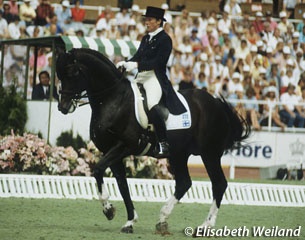
On one of the finest Swedish summer days in 1990 a Scandinavian fairytale had a happy ending in the venerable Olympic stadium of Stockholm. This fairytale had started in Denmark in 1982 and which put Finland on the map of international dressage.
It encouraged countless dressage riders and made one rider a name internationally and her horse immortal: Matador.
A Scandinavian Joint-Venture
When Matador (by May Sherif x Wersal) was born at his breeder Georg Möllebjerg’s barn in Denmark in 1979 his rider Kyra Kyrklund had just started her international career with a small chestnut called Piccolo. In Denmark the young Finnish woman met the Danish bred colt which was being prepared for the stallion licensing in Herning. She immediately liked the dark youngster. Nobody could sense that this very day was the beginning of an inspiring story, least of all Kyra herself. As a young rider without a strong financial or horsey background she had no chance to buy the Danish stallion.
“Meeting Matador as an unbroken colt I could see that he had a lot of personality. I only saw him loose, but he had very good balance. I really liked him, but he was too expensive for me,” said Kyra about that day in 1982.
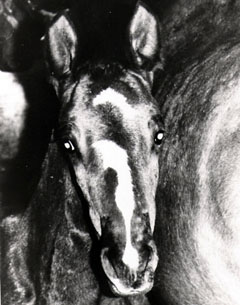 After having spent some years at the Swedish national riding school in Strömsholm in the 1970s Kyra had set up her own training stable at Helsinki which she had rented from the city council of Finland' capital. Though there was no chance to buy the youngster herself, luck was on her side at the right time. Just when she came home from Denmark one of the horse owners in her stable, Heikki Soras, told her he intended to buy a young stallion.
After having spent some years at the Swedish national riding school in Strömsholm in the 1970s Kyra had set up her own training stable at Helsinki which she had rented from the city council of Finland' capital. Though there was no chance to buy the youngster herself, luck was on her side at the right time. Just when she came home from Denmark one of the horse owners in her stable, Heikki Soras, told her he intended to buy a young stallion.
Of course Kyra reported him on Matador and Soras, a businessman with a passion for horses, went to Denmark and bought the horse. In doing so he enabled Kyra to bcome an equestrian superstar, but nobody could know this. On the contrary, Matador was never bought to become Kyra’s competition horse. “Soras bought and sold horses. When he bought Matador I knew from the beginning he wasn’t going to keep the horse for me as a sponsor. I only should train the horse to be sold later on."
A Noise-sensitive Highly Talented Horse Quickly Climbing the Ladder
Whomever had the honour of seeing Matador II live in the show ring, would be surprised to know that this beauty of a horse hadn’t been very impressive as a youngster.
“As a young horse Matador did not own the big natural movements. I remember that people who saw him had not been too impressed. But he owned an amazing balance and everybody who sat on him told me he felt like a luxury car with servo steering and automatic gearbox," Kyra reminisced.
From the very beginning work with Matador was a pleasure as he was very energetic and sensitive, but never spooky. Kyra stressed that her stallion was such a quick learner, but as usual with highly talented horses, she also knew that this only would work to her advantage if she avoided mistakes in the horse’s training.
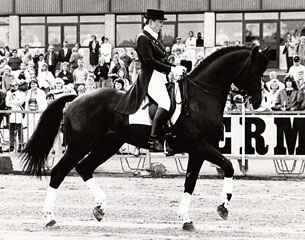 “He learned very quickly, also the bad stuff," Kyra confessed. "Thanks to his athleticity everything was so easy for him. If I was just quick enough praising his correct behaviour he picked it up fast.” Due to this Matador’s daily training always demanded Kyra’s complete concentration, but they would also use the big Helsinki Central Park near the stable to do a nice hack and on one of those Matador decided to learn piaffe later on.
“He learned very quickly, also the bad stuff," Kyra confessed. "Thanks to his athleticity everything was so easy for him. If I was just quick enough praising his correct behaviour he picked it up fast.” Due to this Matador’s daily training always demanded Kyra’s complete concentration, but they would also use the big Helsinki Central Park near the stable to do a nice hack and on one of those Matador decided to learn piaffe later on.
In 1984, the year in which Kyra represented her country at the Olympic Games in Los Angeles, her talented youngster made his show debut at L- level. The 5-year old Matador won, but Kyra admitted that he had been a bit too hot. Even though the beautiful stallion with the striking blaze and characteristic black dots on his white legs learned the movements easily, he was very sensitive to noises. Due to this Kyra decided after the first shows that her apprentice and groom back then, Tiina Rikkonen, should take the stallion to the shows only to get him used to the environment and noises. “We did a lot to desensitise him. At shows we took him out several times a day and just jogged around to get him settled in. When he didn’t overreact to noises from behind he was ready to go to the show ring.”
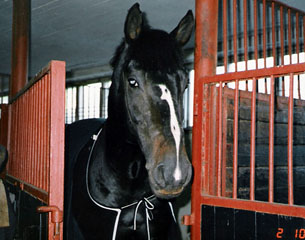 Matador was also lucky that his rider had always been interested in new ways of communicating with horses and so Linda Tellington- Jones, a renowned Canadian animal trainer, worked with Matador. Nowadays Tellington-Jones and her method based on several touches on the horse’s body are well known internationally and have been applied on horses of Christine Stückelberger, Nicole Uphoff, Nadine Capellmann or the Balkenhol family among others. However, when Kyra asked Linda to show her the relaxing exercises on Matador it was something new and rather unconventional, but “these exercises had been very helpful for Matador.”
Matador was also lucky that his rider had always been interested in new ways of communicating with horses and so Linda Tellington- Jones, a renowned Canadian animal trainer, worked with Matador. Nowadays Tellington-Jones and her method based on several touches on the horse’s body are well known internationally and have been applied on horses of Christine Stückelberger, Nicole Uphoff, Nadine Capellmann or the Balkenhol family among others. However, when Kyra asked Linda to show her the relaxing exercises on Matador it was something new and rather unconventional, but “these exercises had been very helpful for Matador.”
Only a year after Matador’s show debut at L- evel the 6-year- old did his first Prix St Georges competition in the autumn of 1985 at the Nordic Championships in Finland. Kyra clearly remembered that Matador did a faultless test: “I was over the moon with him. Unfortunately the judges hadn’t the same opinion and placed him last in that class.”
Grand Prix Debut at Age Seven
Even for a quick and eager learner like Matador climbing up to S-level was not a walk in the park, but it is amazing to hear how naturally he learnt several of the difficult Grand Prix movements and how Kyra managed to teach him the important extended trot.
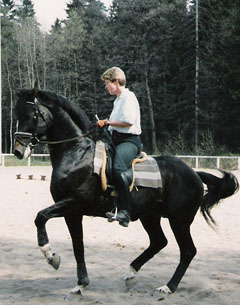 “Piaffe he learned already as a 5-year-old on his own on the way home from trail rides through the forests when he didn’t want to walk to the stables. I wasn’t too worried about the walk and encouraged him to do piaffe. He did a good walk later when he was relaxed. His trot work really changed when Matador was 6. I was trotting on a small circle and without me ever asking he suddenly offered the passage. The technic of the extended trot he learned on a soft spot at our outdoor arena. He had always become too quick before, doing fast and short steps, but now the soft surface slowed him down and he learned how to lengthen his strides without getting faster.”
“Piaffe he learned already as a 5-year-old on his own on the way home from trail rides through the forests when he didn’t want to walk to the stables. I wasn’t too worried about the walk and encouraged him to do piaffe. He did a good walk later when he was relaxed. His trot work really changed when Matador was 6. I was trotting on a small circle and without me ever asking he suddenly offered the passage. The technic of the extended trot he learned on a soft spot at our outdoor arena. He had always become too quick before, doing fast and short steps, but now the soft surface slowed him down and he learned how to lengthen his strides without getting faster.”
As easy as the trot work developed, working on the canter was harder and the flying changes were the last hurdle before entering S-level: “The canter had been the biggest problem. Matador got hectic and showed some difficulties learning the single flying changes. In spring 1985, being 6, he started to cope with them. First they had been rather quick, short and a bit from side to side, but with time they got a lot better."
Even though Matador found most things in dressage incredibly easy Kyra originally did not intend to let her horse have his Grand Prix debut at age seven. Rather accidentally it happened to be that at the renowned Swedish show in Falsterbo there was no small tour in 1986 and so Kyra thought “I might as well start the Grand Prix," she said. "In fact his problem hadn’t been the “tricks”, but to get him mentally settled.”
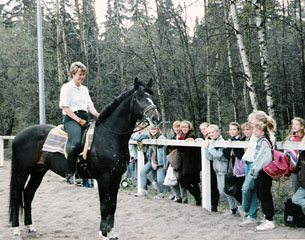 Matador’s first Grand Prix was actually not without tension and also not without some mistakes, but at Falsterbo he really showed promise and impressed the judges who placed him second.
Matador’s first Grand Prix was actually not without tension and also not without some mistakes, but at Falsterbo he really showed promise and impressed the judges who placed him second.
The next day the Danish stallion even won the freestyle class and without a doubt not only the judges, but also the public had spotted a new darling. Of course Matador had that favoured dark colour, he moved with lots of power and elasticity and owned the typical impressive stallion- conformation, but that could be said of other horses at the time as well. However Matador soon gathered a fanclub which had 3,000 members at its height. This was caused by the great charisma he expressed and which distinguished him from many other dressage horses.
Kyra confirmed it: “I think most people got struck by his charisma. He had a way of looking at people. He really looked at them in the way of making eye-contact. In the stable nobody would pass him without stopping and looking back, it didn’t matter if they were horsey people or not. And somehow he was a mixture between a super athlete and a teddy bear, soft but strong.”
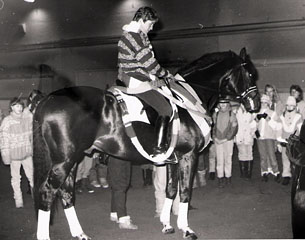 Another characteristic of Matador many might remember was his thick forelock which charmingly flew in all directions when he moved. At the beginning Kyra had always braided his forelock as usual with dressage horses: “But as he had lots of mane we jokingly said that he looks like a frog with a plaited forelock. So at the CDI Zuidlaren I decided to let it loose. When I rode in on the centreline I remember the judge at C excitingly showing his secretary Matador’s forelock. That was the moment when I decided it was going to be Matador’s “trademark”.”
Another characteristic of Matador many might remember was his thick forelock which charmingly flew in all directions when he moved. At the beginning Kyra had always braided his forelock as usual with dressage horses: “But as he had lots of mane we jokingly said that he looks like a frog with a plaited forelock. So at the CDI Zuidlaren I decided to let it loose. When I rode in on the centreline I remember the judge at C excitingly showing his secretary Matador’s forelock. That was the moment when I decided it was going to be Matador’s “trademark”.”
A Partnership in Danger
Though Kyra admitted that not all judges liked Matador from the beginning because he could be tense, many others recognised the great potential in the horse. The extremely encouraging success at Falsterbo was soon overshadowed by serious worries. Matador’s long time owner Heikki Soras decided to sell his horse after Falsterbo and offered the Finnish Equestrian Federation the option to buy him within three months. They tried to get a syndicate together but failed and it seemed very likely that Kyra would lose her rising star before she could harvest the fruits of her work.
“On the last afternoon before the contract ended a friend of mine, Jarmo Karmavuo, came to see me in the stable. He and his wife owned a stud called Kytäjän Kartanot where they bred jumpers. I told him I was feeling very bad as it was the last day the contract was valid and because I was sure I would lose Matador.”
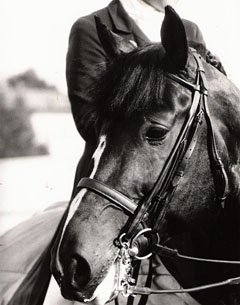 Karmavuo had already been asked to join for a smaller share, but when Kyra told him the majority of the money wasn’t secured he phoned his wife who agreed. Kyra happily recalled that lucky day: “Jorma phoned the bank and the national federation and three hours later the deal was done, it was unbelievable! The new owners of Matador was a “syndicate” of Kytäjän Kartanot Stud, the Finnish FN and myself.”
Karmavuo had already been asked to join for a smaller share, but when Kyra told him the majority of the money wasn’t secured he phoned his wife who agreed. Kyra happily recalled that lucky day: “Jorma phoned the bank and the national federation and three hours later the deal was done, it was unbelievable! The new owners of Matador was a “syndicate” of Kytäjän Kartanot Stud, the Finnish FN and myself.”
Probably neither Karmavuo nor the Finnish FN had any idea which huge favour they had also done to Finnish Equestrian Sport and the discipline of dressage itself by securing the future of that pair.
In 1987 Finland was able to send a team to the European Championships in Goodwood for the first time with Jürgen Koschel as trainer. Matador, now 8 and more experienced, was the team’s anchor in which also Kyra and Rehbein’s former groom Jenny Eriksson rode. Kyra’s 1984 Olympic horse Nor was presented by Kyra’s student Maarit Raiskio.
Due to Matador’s results in the course of the season there was a clear chance to reach the Grand Prix Spécial if he controlled his temperament. Kyra was lucky that in those times an Intermediaire II test was offered as a kind of warm-up for the team competition, but actually it created a new challenge: “In the Inter II Matador did well until the photographers spotted him and decided that they all wanted a picture of him in the pirouette," she said. The “clicks” of several cameras distracted the noise-sensitive, sparkling stallion in such a way that he shot off and was very unsettled for the rest of his programme.
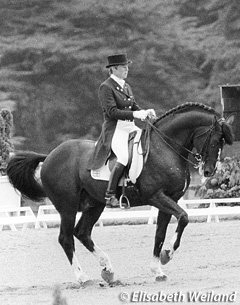 It was not the kick-off for his first international championships and Kyra asked the only Finnish journalist and photographer to ask the other photographers not to take pictures of Matador. As much as one can understand this demand as a rider, for the photographers it seemed impossible not to eternalise this most beautiful black stallion: “The photographers said they couldn’t be told what to do and what not to do and that they were going to photograph us in the Grand Prix the next day.”
It was not the kick-off for his first international championships and Kyra asked the only Finnish journalist and photographer to ask the other photographers not to take pictures of Matador. As much as one can understand this demand as a rider, for the photographers it seemed impossible not to eternalise this most beautiful black stallion: “The photographers said they couldn’t be told what to do and what not to do and that they were going to photograph us in the Grand Prix the next day.”
Instead of sulking Kyra decided to deal with it. In hindsight she thinks that the decision of the photographers was in a way very good because it forced her to deal with Matador’s hyper-sensitivity. She asked a befriended photographer, Kenneth Wrede, to come to the warm-up with his camera the next morning. “He was “clicking” until Matador wasn’t reacting anymore. It did help and we ended 8th individually.”
Goodwood was only the beginning of Matador’s impressive rise to fame as he improved steadily in his performances and rankings.
An Olympic Blow
Although international judges, experts and parts of the public had realised that this huge black stallion was a special horse with a potential to place at the very top of the game, it seemed a little bit unlikely that a Finnish rider would show the leading Germans their hind hooves ahead in the race. When they opened their 1988 Olympic campaign at CDI Neumünster in February Matador left no doubt and won the competition which caused a stir in Germany as well on the whole dressage scene.
It has to be mentioned that Kyra was no complete newcomer; she had first represented Finland at the 1978 World Championships in Goodwood and finished fifth in the boycotted Moscow Olympic Games on Piccolo in 1980. Yet it came as a surprise that this Finnish competitor was now so very competitive.
Matador got a well earned rest after his triumphs on German turf and was shown again at the renowned Hamburg Dressage Derby in the spring which he won. Later at the CDI Wolfsburg in June he met the German Olympic candidates. Matador performed brilliantly, winning the Grand Prix and the Spécial ahead of the later Olympic champion Rembrandt.
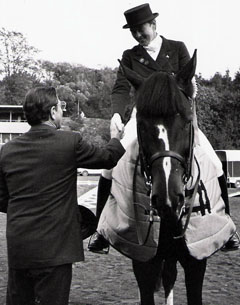 From that moment on he was a favourite for the individual medals. Unfortunately Matador could not contest with even more serious medal candidates at the CDIO Aachen only 10 days later as he got a cold and had to be withdrawn.
From that moment on he was a favourite for the individual medals. Unfortunately Matador could not contest with even more serious medal candidates at the CDIO Aachen only 10 days later as he got a cold and had to be withdrawn.
At Seoul he was on such a form that he drew a lot of attention in the two weeks before the Grand Prix began. Unfortunately the huge stadium in South Korea wasn’t a very quiet one. Matador made some mistakes in the flying changes, but still finished fifth not far behind Ganimedes and Gauguin de Lully which placed 3rd and 4th. The Finnish team ranked a surprising 6th mainly thanks to their anchor’s strong performance which left all possibilities open for the individual final.
What could have become Matador’s crowning day ended with Kyra’s worst disappointment in their career together: “I think Seoul had been my biggest disappointment. We really had a medal chance and I blew it," she admitted. "Still I did learn something very valuable there and that was not to change anything in my preparation just because it is an important competition. I warmed Matador up a bit shorter than usual to have him more fresh, but it resulted in him blowing up a few times. I was taking too big a risk going for the gold medal and ended up in 5th place.”
Escaping Death and Fighting Back
In the spring of 1989 Kyra started Matador at a national Swedish show in Strömsholm. Now a renowned international Grand Prix horse Matador had no problem winning all classes and after that travelled to the stud of his Finnish owner to cover for a couple of weeks. Matador covered his entire sport career and, according to Kyra, never reacted to mares on shows until the dark time came that lay ahead of him.
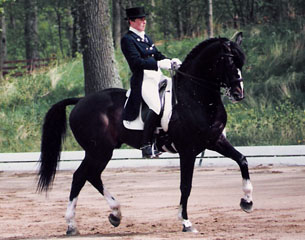 Two days after he had come back to Helsinki Kyra thought that Matador felt tired in the training and when he even refused to eat in the afternoon the same day the vet was called. “She treated him and thought it wasn’t too bad. We continued to monitor him and suddenly, probably because the effect of the painkillers lessened, he was in big pain. The vet came back and very quickly decided Matador had to be operated due to a twisted intestine,” Kyra stated.
Two days after he had come back to Helsinki Kyra thought that Matador felt tired in the training and when he even refused to eat in the afternoon the same day the vet was called. “She treated him and thought it wasn’t too bad. We continued to monitor him and suddenly, probably because the effect of the painkillers lessened, he was in big pain. The vet came back and very quickly decided Matador had to be operated due to a twisted intestine,” Kyra stated.
Still today, more than 20 years later, a colic operation is a very serious affair, but it was even more so in 1989 when it wasn’t done as often as nowadays. Luckily Kyra’s stable in the middle of Helsinki was located ideally in two aspects: The Helsinki University Equine Hospital was quite near and Matador’s transport there was helped by the police which had their station next to the stables and escorted the suffering horse in the trailer with blinking lights and alarm signals.
Matador was immediately operated and to everybody’s relief the operation itself and the critical time afterwards went well. However, the wonderful horse wasn’t out of danger as only a few weeks later he sustained a huge hernia (eruption of the inner muscle wall). Such operations were in their infancy back then and moreover with Matador’s general constitution not yet strong enough, it posed a risk.
Kyra explained that, “we decided to let him recover and get him back in better condition before doing anything about the hernia. We asked for advise all over the world, but nobody really dared doing a thing. In the end Harry Petterson of the Equine Hospital in Sweden said he could try operating the hernia by closing the muscles with a net. We took him to Sweden and the operation was done successfully in autumn of 1989.”
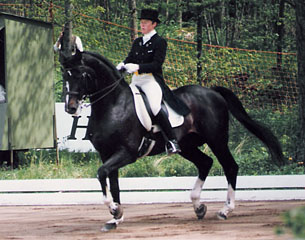 At the beginning of his rehabilitation Matador was very weak and according to Kyra also a bit depressed. One day a class of school kids came to Kyra’s stable to look at the horses. On this occasion Matador was plaited and taken to the indoor school with all those children. “He looked at the ‘audience’, loved it and it was from that moment on Matador had decided to come back."
At the beginning of his rehabilitation Matador was very weak and according to Kyra also a bit depressed. One day a class of school kids came to Kyra’s stable to look at the horses. On this occasion Matador was plaited and taken to the indoor school with all those children. “He looked at the ‘audience’, loved it and it was from that moment on Matador had decided to come back."
Kyra stressed the important role of her former rider Janne Bergh, today herself an international dressage rider and still running Kyra’s stable in Helsinki after she left for living in England: “Janne was invaluable in Matador’s rehabilitation after the operation. She led and trotted him for hours in hand out in the Central Park in Helsinki not far from our stable.”
1989 surely had been a very hard year for Matador and his rider, but Kyra seems to find a positive aspect in everything: “When he did have this colic operation it really made me realise that I was not going to have him forever and that made me appreciate every time I could sit on him!”
A Glorious Come Back as Career Highlight
When Matador came back to the show ring in 1990 only a visible bigger scar on his belly reminded everyone of the operations which saved his life. At his first show after more than one year the rumours around him were squashed. “There had been rumours of him being dead and people didn’t believe me when I said Matador was ridden and on his way back,” Kyra disclosed.nWith only few horses really recovering from severe colic operations at the time Matador was a miracle by coming back better than ever before!
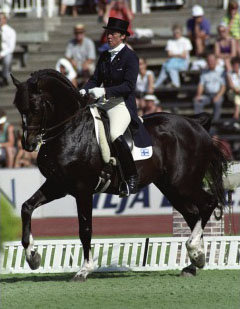 At the first World Equestrian Games in Stockholm the public saw a horse that was completely concentrated on his rider and moved with power and ease while at the same time executing all these difficult movements of the Grand Prix. The crowded Olympic stadium of Sweden’s capital with its towers at every corner, the green sand of the arena and the sunny blue sky provided a magical setting for those championships.
At the first World Equestrian Games in Stockholm the public saw a horse that was completely concentrated on his rider and moved with power and ease while at the same time executing all these difficult movements of the Grand Prix. The crowded Olympic stadium of Sweden’s capital with its towers at every corner, the green sand of the arena and the sunny blue sky provided a magical setting for those championships.
Everybody saw Matador dance his way to the individual silver medal and the spectators will never forget the picture he gave and the determined will he expressed to do it right for his rider. One almost could get the impression that he enjoyed it tremendously to show himself at his best to the thousands who adored this Scandinavian pair.
Not even Rembrandt and Nicole Uphoff were welcomed so warmly and were celebrated that frantically as Matador and his beaming rider during the prize-giving ceremony. “Stockholm had definitely been my greatest success with Matador. Not so much because we won the silver medal there, but because he had come back after the colic operation,” Kyra mentioned.
On Scandinavian turf a Scandinavian pair had written their own history which was more a fairytale than anything else. Without a strong financial background, being a rider from a country far away from the sport's beating heart and quite an unknown rider before Kyra had worked herself up the ladder thanks to that outstanding stallion to whom she dedicated so much over the past eight years. In Stockholm Matador and Kyra had established themselves as one of the all-time greats of dressage.
Parting after World Cup Win
After the 1990 WEG the future looked bright for the only 11-year-old Matador and his rider; even more so when they received a wild card to compete at the 1991 World Cup Fnal in Paris.
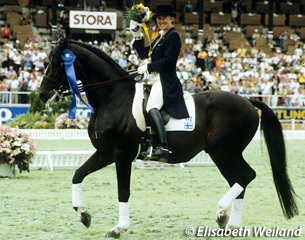 The indoor arena at Paris-Bercy is not the most quiet place for dressage horses, but Matador was now experienced and obedient so this didn’t influence his performances. Though he made some mistakes in the Grand Prix, he still won ahead of another May Sherif-offspring, Sven Rothenberger's Andiamo (formerly named Mayday). In the freestyle Matador thrilled the crowds with a choreography which played with the limits of the FEI rules. Matador's kur became famous for its piaffe-pirouette which changed into a canter-pirouette. Matador was by now so reliable that Kyra could ride piaffe and passage single-handedly. In the end Matador won the World Cup Final which was their first international title.
The indoor arena at Paris-Bercy is not the most quiet place for dressage horses, but Matador was now experienced and obedient so this didn’t influence his performances. Though he made some mistakes in the Grand Prix, he still won ahead of another May Sherif-offspring, Sven Rothenberger's Andiamo (formerly named Mayday). In the freestyle Matador thrilled the crowds with a choreography which played with the limits of the FEI rules. Matador's kur became famous for its piaffe-pirouette which changed into a canter-pirouette. Matador was by now so reliable that Kyra could ride piaffe and passage single-handedly. In the end Matador won the World Cup Final which was their first international title.
The 1991 European Championships in Donaueschingen could have been another possibility to add glory to Finnish dressage, but then something happened which had threatened the partnerships already 5 years earlier: The Finnish Stud which owned the majority of Matador got into economic troubles and was no longer able to keep their most famous stallion. Sadly Kyra had to part with Matador in 1991 when her long time partner sold to a Japanese businessman who intended to ride at the 1992 Olympic Games.
After almost 10 years together it must have been a real blow. Not only from a sportive point of view, but more so from a personal: “I don’t want to rank my horses, they are like friends. All are different and one isn’t better than another. But with a horse that had been such a big part of your life, you have a different relationship.”
Kyra found a new black stallion in Russia, a very different type to Matador: Edinburg. One year later she competed against her best horse ever at the 1992 Olympic Games in Spain. Kyra again finished 5th on her new acquisition as she had done with Matador four years earlier. Unfortunately Matador with his new Japanese rider aboard only finished in 41st place out of 48 starters.
Of course his rider was far less experienced than Kyra, but it also showed that success in dressage isn’t just a question of money, but of building a partnership based on faith and mutual respect which takes a long time. Kyra reported that after Barcelona Matador went briefly to Nicole Uphoff before he was retired to stud. At age 14 Matador's outstanding sport career came to an end.
Matador’s Legacy
Over the past years quite a few Matador offspring have been competing at S-level in Finland. Not only in the native country of his rider, but also in Denmark and Germany among other countries one will find his "babies" in sport. When Matador first met Kyra in 1982 he was heading for the stallion licensing in Herning and got licensed for one year which still is the rule for 3-year-olds in Denmark. Even after he sold to his new Finnish owner, Matador remained in Denmark over the summer to do his first breeding season.
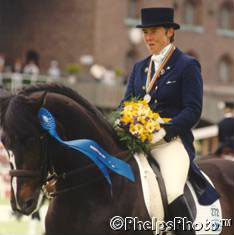 According to Kyra Matador only produced very few mares, approximately 5. Matador gave a first taste of his quality by siring a very special mare: Matadie (dam by Saskibard x Sable Skinflint xx). She gave birth to two brilliant dressage mares: Richard Davison’s 2004 Olympic mount Ballaseyr Royale (by Picandt, DWB) and Andreas Helgstrand’s short-lived super-star Blue Hors Matine (by Silvermoon/ Trak., DWB).
According to Kyra Matador only produced very few mares, approximately 5. Matador gave a first taste of his quality by siring a very special mare: Matadie (dam by Saskibard x Sable Skinflint xx). She gave birth to two brilliant dressage mares: Richard Davison’s 2004 Olympic mount Ballaseyr Royale (by Picandt, DWB) and Andreas Helgstrand’s short-lived super-star Blue Hors Matine (by Silvermoon/ Trak., DWB).
Because Matador went to his new home in Finland in the autumn of 1982 he couldn’t do the required performance test in Denmark and lost his licensed status for the DWB society for a while until he was fully approved with the DWB based on his performance results. Matador did his performance test in Finland and because he also showed very good jumping abilities the Finnish Warmblood Association approved him.
The entire time Matador had been in Finnland with Kyra he covered at Kytäjän Kartanot stud. Though he seems to rather have left a stamp as sire of outstanding broodmares Kyra was told that at least 75% of his offspring had been started at PSG-level. For example Kyra’s former rider Janne Bergh competed on a stallion called Conquistador S (by Matador) up to S-level.
Kyra herself values the offspring of her former star horse quite a lot: “Most of them are really easy to ride on the bit and they learn fast.” Consequently she has Matador blood in her own stable in England today. One knocking on the door to Grand Prix-level is the 11-year- old Finnish warmblood gelding Matata (by Matador out of a dam by Kyra’s 1996 Olympic horse, the Swedish bred Flyinge Amiral). “I bought him as a foal. He is trained to Grand Prix, is doing all the movements now and will soon be ready to go out," Kyra told Eurodressage.
”He showed me it was possible”
Matador was located at the famous Böckmann stallion station in Germany for a few years before he returned to his breeder Georg Möllebjerg in Denmark where he stood at stud together with his father May Sherif. In April 2002 Matador had to be put down there. He is buried in an animal graveyard in Denmark under a birch tree.
For Kyra not only a very dear friend and her most successful sport partner had gone, but also the horse that made her a name internationally.
“I think Matador had put dressage on the Finnish sports' map. Finns are very keen on sport and Matador became a horse that everybody recognised. As a pair we really represented the success “against all odds”. I believe we gave hope to many riders that it was possible to be successful if you have some “finnish sisu” (willingness to go for it) and if you are really dedicated enough. Matador had shown me that it is possible. The funny thing with him was that I feel it was destiny we stayed together. Even if I never had the control of his ownership I always stayed in touch with him and influenced his life the best way I could.”
Article by Silke Rottermann for Eurodressage.com - NO REPRODUCTION ALLOWED
Photos © Dirk Caremans - Mary Phelps - Elisabeth Weiland - private - NO REPRODUCTION ALLOWED
Related Links
Rider in the Spotlight: Kyra Kyrklund
Matador Passed Away
Andreas Helgstrand and Matine, 2006 Danish Dressage Champions
Ballaseyr Royale to Retire to a New Career as Brood Mare
Video of Matador at the 1999 Danish warmblood stallion show in Herning